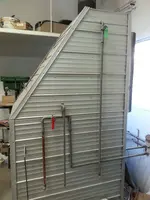spudnick
Jr. Member
- #101
Thread Owner
For sure Jim, Seems like an optimum level is needed for efficiency with a low pressure pulse unit. By the way, that last test i did was a rough estimate. ( guesstamite ) , water volume and p/p/min . I should have set up a timer to count the P/P/min accurately. It was a sloppy test , just to get a rough idea on effect. Well, if your jig is running 9 gal. min + , that makes a lot of sense, as per screen box size. A lot of variables to consider... Ken
Trapped air, another concern for sure, especially with a tall stand pipe. My vacuum pump test i did with the steel stand pipe was not conclusive. I did find that there was not very much air trapped, but how much ? Was difficult to measure. I was surprised , thinking there would be substantial air at the top. If a stand pipe valve was installed at the lower stand pipe area. The closed system could be pressurized to blow off the air , through a top level bleed off- valve. OR, a strategic site glass installed to visually inspect the internal actions in progress.
: Example of trapped air in a low pressure water circulation system.:
This picture is an enclosed wood heater ,that heats water running through 2 radiators. One radiator laying horizontal ( red tape ), and a vertical radiator to the right ( green tape ). I run this system at 5 PSI, with a 60 watt magnetic drive pump. The pump pushes water into the bottom ( red tape )area horizontal rad, water carrys on through the vertical rad, and out at ( green tape ) area. The hot water then goes down to floor heat manifold... So, at times ,i have air trapped that will not migrate downwards. I have to Pressurize the water system to 20-30 psi, then open the (green and red tape) valves to blow out the air. If i do not pre- pressure and just crack the (green tape) valve open, it will suck more air in. .. That is why i expected an air pocket in the pulse valve. May be worth building in a design to eliminate the possibility of air ? like you say Air in the system , even with my mechanical jigs, has a negative effect.): Even a very small amount of air. ?
Air in the system , even with my mechanical jigs, has a negative effect.): Even a very small amount of air. ?

Trapped air, another concern for sure, especially with a tall stand pipe. My vacuum pump test i did with the steel stand pipe was not conclusive. I did find that there was not very much air trapped, but how much ? Was difficult to measure. I was surprised , thinking there would be substantial air at the top. If a stand pipe valve was installed at the lower stand pipe area. The closed system could be pressurized to blow off the air , through a top level bleed off- valve. OR, a strategic site glass installed to visually inspect the internal actions in progress.
: Example of trapped air in a low pressure water circulation system.:
This picture is an enclosed wood heater ,that heats water running through 2 radiators. One radiator laying horizontal ( red tape ), and a vertical radiator to the right ( green tape ). I run this system at 5 PSI, with a 60 watt magnetic drive pump. The pump pushes water into the bottom ( red tape )area horizontal rad, water carrys on through the vertical rad, and out at ( green tape ) area. The hot water then goes down to floor heat manifold... So, at times ,i have air trapped that will not migrate downwards. I have to Pressurize the water system to 20-30 psi, then open the (green and red tape) valves to blow out the air. If i do not pre- pressure and just crack the (green tape) valve open, it will suck more air in. .. That is why i expected an air pocket in the pulse valve. May be worth building in a design to eliminate the possibility of air ? like you say
 Air in the system , even with my mechanical jigs, has a negative effect.): Even a very small amount of air. ?
Air in the system , even with my mechanical jigs, has a negative effect.): Even a very small amount of air. ? 



